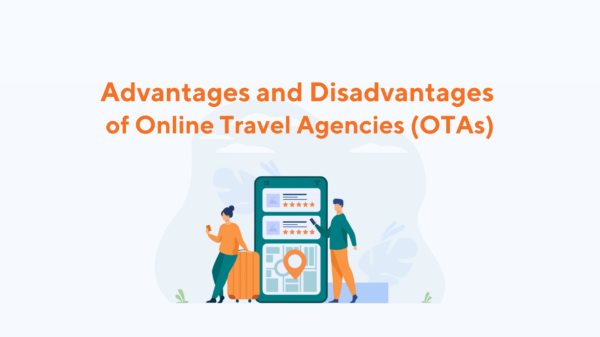It can be easy to rest on your laurels after starting a tour operator business. You’ve identified a market, researched the competition, developed a suitable business plan for a tour operator company, come up with a name and brand identity, created your travel offering, and launched into your target market. Bookings are steady, customer reviews so far are positive, and you’re feeling good about where you’re at. Kudos!
However, the real hard work starts when thoughts turn toward sustainable growth. How do you take your fledgling travel business and grow it over the long-term? How do you grow and stay ahead of your rivals in the competitive tourism industry? How can you keep customers coming back for more and make sure every review is a positive one?
To become a successful tour business, you need to do certain key things right—from building a user-friendly website to ensure people can find you online to selecting the right online booking system. Here’s our guide to the top 10 things you can—and should—do now to start building your business.
1. Proactively plan for your tour company for growth
A business plan for a tour operator company typically includes your business model, value proposition, target market, finances, structure, and sales and marketing strategy. While most tourism business plans also include a vision for the future, often at minimum a five-year plan, your main focus may have been getting your business up and running.
After launch, you need to revisit your business plan and put together a growth plan. As James Cash Penney, founder of retail giant JC Penney said: “Growth is never by mere chance; it is the result of forces working together.”
Imagine where you want to be in five or 10 years and set some longer-term goals if you haven’t already. These could include:
- Find gaps in the travel market to expand the tours and activities you offer
- Identify and target different markets
- Expand into more cities and countries
- Partner up with other travel or activity companies
As well as setting some objectives, an effective growth plan involves:
- Focusing on your strengths and how you can build upon them
- Keeping tabs on what your competitors are up to
- Analyzing what’s working and what’s not
- Putting in place the right systems and processes to help you scale up
- Hiring the right people to help you achieve your goals
- Knowing your audience and their changing needs
The rest of this article looks at some of the specific things you can do to achieve your objectives and grow your tourism business.
Tips for success #1: Never stop planning
Your business and growth plans shouldn’t sit on a shelf gathering dust. They are living documents that you should revisit every so often. Hold regular planning meetings with your leadership team and other staff to develop new goals and refine existing ones.
2. Know what makes your tour business, you
Long-term growth requires your business to have an evident, focused value proposition. Unless everyone involved in your business is crystal clear on your unique selling point and what value you offer, it can be hard to convince people to choose you over competitors.
If you try to do too much—for example, diversify into too many different activities—or stray too far from your central value proposition, you can devalue your business offering.
If you haven’t already done this as part of your business and marketing planning, come up with a value proposition statement that focuses on why you’re different and the value you offer.
Develop your value proposition with a small group first, then test it with more people. Focus on your customers, their needs, and how you meet those needs, as well as the value and benefits you offer. Evolve and refine your value proposition as your business grows and changes over time.
Tips for success #2: Develop a value proposition
A Google employee created a simple formula for developing a value proposition: “We help (X) do (Y) by doing (Z).” For example, “We help culture vultures combine their love of art and travel by organizing arts-focused tours to the world’s top cultural destinations.”
3. Ensure your tour website is up to the job
The days when a tourism-focused website was just an online brochure are long gone. Your website needs to be a marketing, sales, bookings, and customer service superhero. Your online presence should help you to:
- Communicate who you are and what you do
- Attract visitors through Google and other search engines
- Convert visitors into leads and prospects
- Engage with prospects and customers online
- Deliver better customer service
- Measure your marketing using online analytics tools
- Manage your business more effectively through integrated online travel booking software and other tools
One thing to pay attention to is the experience of first-time visitors to your website. Earlier, we looked at the importance of your value proposition. A version of this should be one of the first things people see when visiting your website. Make sure you leave people in no doubt about what you do and, more importantly, what you can do for them. Think of it as your “elevator pitch.”
For example, Phare is a Cambodian circus that also helps Cambodian youth. This is how it presents its value proposition on its website:
AMAZING VIBE & ENERGY, TRANSFORMING THE LIVES OF CAMBODIAN YOUTH
Siem Reap’s most unique, authentic top rated evening entertainment.
More than just a circus, Phare performers use theater, music, dance and modern circus arts to tell uniquely Cambodian stories; historical, folk and modern. The young circus artists will astonish you with their energy, emotion, enthusiasm and talent.
No-one reading can be in any doubt about what Phare is all about. The rest of the web copy fleshes out the value proposition and provides more information.
Effective websites are also well-organized, with navigation menu labels that are clear and intuitive. Your website’s aim should be to help visitors easily and quickly navigate to where they want to go and complete specific tasks, such as finding a tour, making a booking, or contacting someone.
Of course, your website should also look great—photography is an important part of any tour operator website—and be well-written and accessible on any size of the screen. Remember, your site reflects your business, and your business is all about delivering great experiences. That includes the experience of a visitor to your website.
Tips for success #3: Maintain your website
A website is never finished. You can always tweak the copy, add more content, optimize it for search engines, integrate new tools, and improve both its marketing effectiveness and visitors’ experience.
4. Provide outstanding customer service for your tours
Travel businesses need to be 100% focused on their customers at all times and every stage of the customer journey.
After all, being in the travel and tourism business means you’re really in the “experience” business. That experience can start even before someone visits your website—for example, if they read a social media post or a review. It can then continue through their buying journey from prospect to customer, during the tour itself, and after the tour. At each stage, customers will form opinions about both the experience you provide and how you deliver it.
With multiple ways for people to leave both positive and negative feedback—through social media, Google Business reviews, Trip Advisor, and other mediums—providing outstanding customer service alongside great customer experiences is vital to your continued success.
Prioritizing customer service helps you grow your business, differentiate yourself from competitors, and build trust with your target audience.
What does outstanding travel customer service look like? It all starts with knowing who your ideal customers are:
- How old are they?
- What life stage are they at, e.g. students, retirees, parents with kids…?
- What are their unique needs and wants?
- What’s their budget?
When you know who they are and what they need, you can target your tours appropriately and market and communicate effectively during their customer journey. You can also grow your business by adding new tours you think might appeal to your market. If you know your customers and establish a good relationship with them, you also stand more of a chance of being able to pivot and adapt during bad times.
Besides getting to know them, it’s all about providing the best experience possible. Here are a few customer service best practices:
- Interact with customers and prospects on social media
- Make booking quick and easy through an online booking system
- Have a clear cancellation policy
- Stay in touch with customers in the lead-up to, during, and after the tour
- Request feedback at the end of the tour
- Be responsive and treat customer complaints with respect and empathy
- Thank people who provide positive feedback
Tips for success #4: Communicate with customers
Customers will have lots of things on their mind in the build-up to their tour and may have questions. Get ahead of them by emailing customers just before the tour with all the details they need.
5. Ask for tour and activity feedback from your customers
Be proactive about collecting tour and activity feedback. Customer feedback can help encourage people to leave reviews online. It also provides valuable insights into the customer experience that can improve your tours and even develop new ones.
There are a few ways to generate feedback:
In-person: Encourage staff—in the office and out on tours—to document the feedback they receive daily. While customers may feel uncomfortable reviewing a tour with the tour guides, they may be open to giving more detailed feedback to a tour manager or someone from the office. Often a simple “How are you enjoying things so far?” and “Is there anything we can do to make your trip better?” is enough. You can also give customers a survey to fill in at the end of their tour.
Online: Another way to collect feedback is through an online survey. Send customers a link and invite them to complete a short survey. In addition to questions, include a blank section that lets them leave any other thoughts.
On review websites: You can also email customers post-tour to invite them to leave a verified review with Rezgo or other travel platforms. Most customers understand how important reviews are to businesses.
Tips for success #5: Display feedback on your website
Add a feed of verified customer reviews to your website. The right tour operator booking platform can automatically display recent reviews on your website.
6. Stay on top of negative customer feedback listed on all platforms
Receiving negative feedback is a fact of life for many travel businesses. This could come in the form of an email or phone call directly to the company, or a public posting on social media, Trip Advisor, Google Business, or another travel website.
Successful tour operators respond to criticism quickly, transparently, and respectfully. Be empathetic to the customer’s situation and feelings and, even if it’s not your fault, try to find a solution that satisfies them. Even just an explanation will satisfy many customers. The offer of a gift card or other reward can even turn a complaint into a marketing opportunity.
If you feel you have to apologize, do so gracefully. Here’s an example of an apology KFC printed in an advertisement after they ran out of, of all things, chicken. It’s honest, doesn’t try to make excuses, and says how it plans to make amends.
“A chicken restaurant without any chicken. It’s not ideal. Huge apologies to our customers, especially those who travelled out of their way to find we were closed. It’s been a hell of a week, but we’re making progress, and every day more and more fresh chicken is being delivered to our restaurants. Thank you for bearing with us.”
If you receive negative feedback online and have the ability to reply, here are some of the ways you can respond to public negative feedback:
- Look at the issue from the customer’s point of view
- Take on board negative comments and respond with how you plan to address them
- Apologize when necessary and try to make amends
- Don’t post a response when you are angry
- Draft your response in advance and only post it when you are happy with it
- Be gracious and polite, even if you feel negative feedback isn’t justified
All genuine feedback is good feedback. You can use customer feedback—good and bad—to make constant improvements to help you grow a successful tour operator business.
Tips for success #6: Responding to negative feedback
It can be hard not to respond to negative feedback you feel you don’t deserve in a knee-jerk fashion. Try to respond within a day, but sleep on it and run your response past your team before posting it.
7. Create content that wows and educates
Content marketing is a powerful—and affordable—marketing tactic for businesses of all sizes. It involves taking a strategic approach to creating and distributing content tailored to your target audience’s interests.
It’s a top-of-funnel marketing tactic designed to make people aware of your business, draw them in, and start the process of converting them into customers.
Great content marketing:
- Drives website traffic from search engines and social media
- Builds awareness of your products and services
- Reaches new prospects and markets
- Engages and connect with your audience in a meaningful, non-salesy way
- Broadens your audience on social media
- Builds trust and credibility with your target audience
- Creates excitement and desire around your tours, locations, and activities
Of course, the foundation of any successful content marketing strategy is a steady supply of high-quality content. Not only eye-catching photographs, evocative videos, and insightful articles, but also content that is:
- Targeted to the needs and interests of your audience
- Shareable and optimized for search engines
- Distributed through the right channels at the right times
- Created using a consistent and appropriate brand voice
Few industries have as much content potential as the travel sector—not just content you can create yourself, but “influencer” and other user-generated content on Instagram and elsewhere. While most successful tour operators use content marketing at the buyer journey’s Awareness and Discovery stages, great content can also encourage repeat business and referrals.
Tips for success #7: Create a content hub
Create a content hub or blog on your website to drive traffic from search engines and social media. High-quality content will encourage prospective customers to stay awhile and explore what you have to offer.
8. Protect your travel and tour business
Don’t just focus on delivering memorable experiences for their customers. The “boring” stuff matters, too. It’s important to ensure you run a tight ship regarding your policies, waivers, insurance, and other unglamorous elements of a professional, well-run tour business.
Here are a few areas to focus on getting right:
Cancellation policy: Hopefully, we won’t need to deal with another torrent of cancellations in the tourism industry, but being clear about cancellations is always a good idea. Depending on your tours’ nature and location, craft a clear cancellation policy and make sure your customers read and understand it. The aim is to protect you and your customers. If you consider using an online tour operator booking platform, look for one that credits cancelled tours to your account.
Waivers: Make it easy to manage any waivers your customers need to read and agree to. The best online booking systems make it easy for customers to sign a waiver at the time of booking and for you to collect and store waivers.
Insurance: Purchasing the right insurance is a cost of doing business in the travel industry. Depending on the nature of your tours, you may be dealing with different types of risk to different people—both customers and staff. Most tour operators need:
- Business protection insurance to protect assets or mitigate against business interruptions
- Public liability insurance to cover risks to customers
- Insurance that covers employees while they are working for you
Tips for success #8: Offer customer insurance
A service like enhanced refund protection can enable you to offer customers insurance for their trip for a small fee as a percentage of their ticket order.
9. Automate key processes within your business
One of the barriers to growing any business can be time management. There are only so many hours in the day, and you probably eat up many of them dealing with the day-to-day tasks of running a business. This leaves little time for long-term growth planning.
Until cloning people move from science fiction to reality, automation is one of the best ways to free up your time to build a successful tour operator business. Successful tour operators automate as much as possible to leave them more time to focus on the things they do best—and enjoy the most. Other benefits include:
- Streamlined sales processes
- More bookings
- More satisfied customers
- Better customer service
- More productive employees
- Increased efficiency
- More accurate record-keeping
Here are a few of the areas you can automate to allow for some breathing space to research new markets, improve your marketing, and focus on other growth-focused activities:
Email marketing: Despite instant messaging and social media growth, email is still alive and kicking as a marketing tool. Email automation, through your online booking software provider, or a service like MailChimp or Constant Contact, lets you send pre-written emails to individuals or groups of people at the right time, without having to compose an email and press send yourself each time. You can also automate the updating of your email distribution list.
Social media posts: Social media is a great way to reach prospects and customers where they like to hang out online. However, it can be time-consuming to create and post updates every day. Platforms like Hootsuite, Loomly, or Later can help you manage a content calendar, create content in advance, and schedule posts to Twitter and other social media channels. It’s a great way to ensure you’re always delivering fresh content to your target audience.
Customer service: These days, customers often expect an instant response. Younger customers, in particular, have grown up with instant messaging. Chatbots are one way to automate your customer service elements to provide fast, 24/7 service. A chatbot can instantly handle the routine questions you might get, such as “What tours do you offer?” while still providing the option to hand off to a real person for more involved queries. You don’t need to use AI, which can be challenging to train and restrict to the topics you want to offer. There are several paid and free chatbot builders out there that offer responses you set up yourself.
Sales: Websites with online booking systems never sleep. They enable people anywhere in the world to book tours 24/7. The ability to sell tours and take payments online is the key to growing your tour business over the long-term.
Tips for success #9: Collect customer email addresses
It’s easy to set up a way on your website for people to subscribe to your email list. This lets you engage prospective customers through a series of automated emails designed to tell them more about what you offer and encourage them to return to your website and book a trip.
10. Optimize online sales and bookings for your tour and travel company
Every successful tour operator offers online bookings and payments. Aside from the actual tours, it’s probably the most important part of your business to get right—especially if you want to scale up your business once it’s up and running.
A quick peek at the alternatives tells you why.
- Manual tour bookings are too time-consuming and expensive. It would be best to have enough staff to operate the phones and manage the tour and activity bookings. Everything from capturing customer details to managing the paperwork to taking payment takes time and costs money. There’s also the inconvenience for customers to only book tours during office hours, not to mention the risks of human error leading to booking mistakes.
- Third-party tour and activity bookings through travel agents, OTAs and others are other options. However, third parties take a portion of your sales revenue and are out of your control. While they can be a valuable sales channel, direct bookings should be your focus.
Enabling customers to book and pay for tours directly from your website turns your website into a 24/7 sales agent. These days, consumers increasingly expect to buy products and book trips and other experiences online, often using their mobile device. Benefits to customers include:
- Fast, easy tour booking, with no waiting on the phone
- Being able to search, browse, and book tours and activities when and where they want
- Convenient online tour payments
The best online booking software can do much more than take payments online from a business perspective. Other features and benefits include:
- Multiple online payment options
- Verified reviews integration
- Secure capture and storage of customer details
- The ability to easily generate sales reports
- Automated, point-of-sale waivers
- Easy management of multiple sales channels
- Integrated analytics and marketing tools
Happy customers lead to healthy businesses. A smooth and convenient online tour booking experience is a great start to your relationship with your customers. The Rezgo booking system provides everything you need to run your business, drive more direct bookings, and get more happy customers.
Tips for success #10: Try before you buy
Try a demo of Rezgo’s tour operator booking software, and see how you can optimize your business to spend more time doing what you love.









